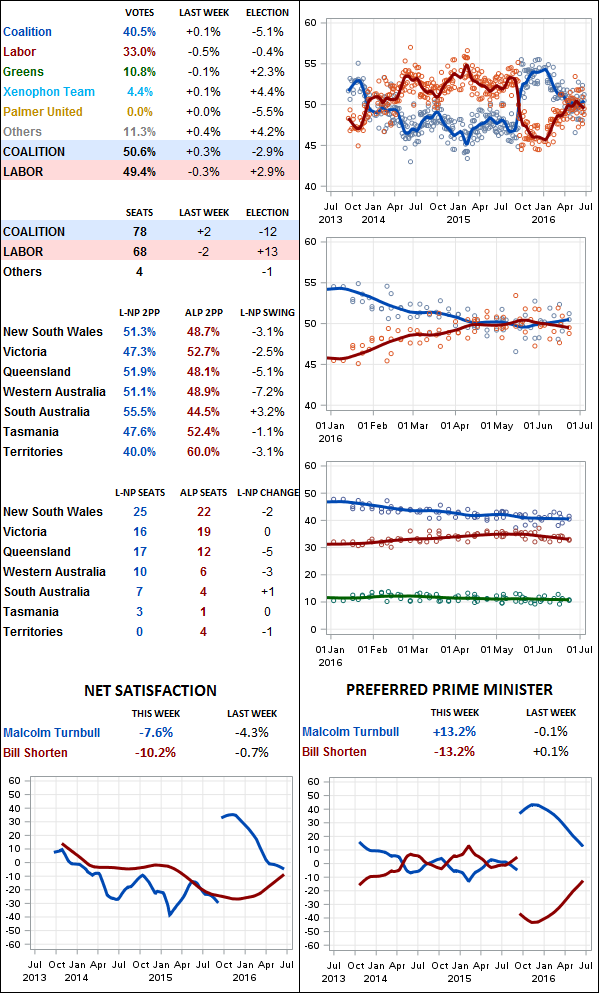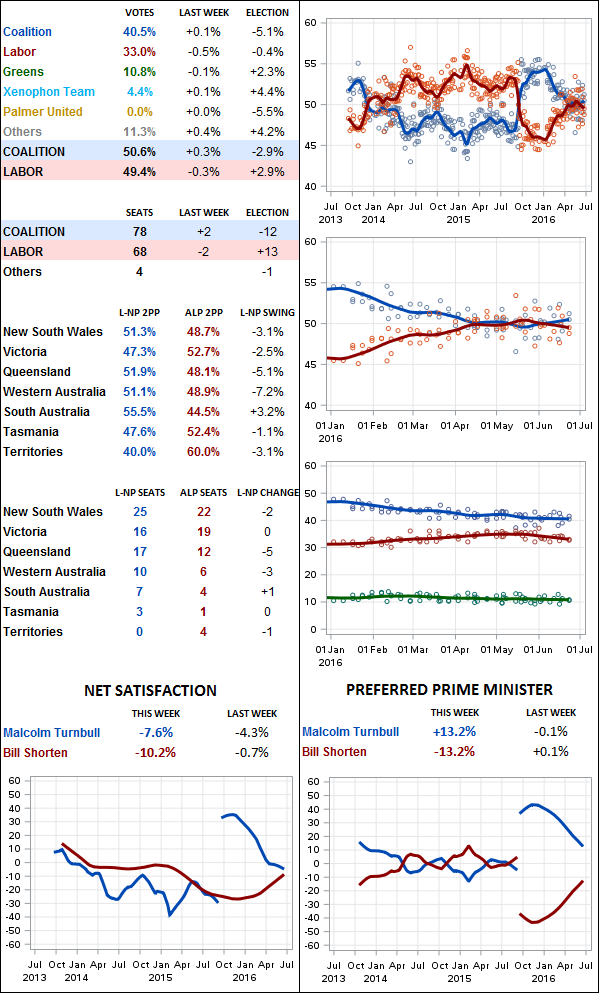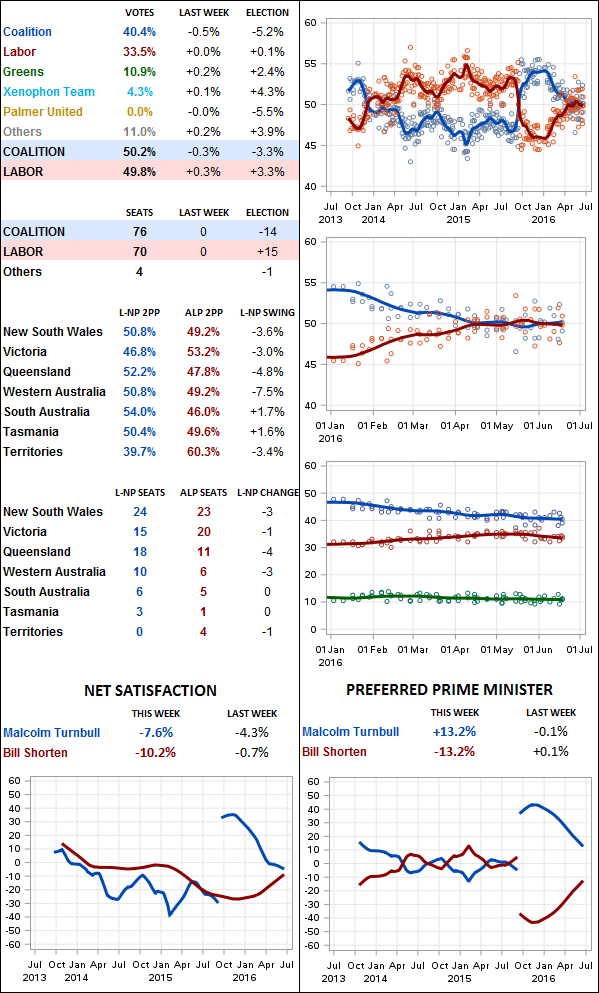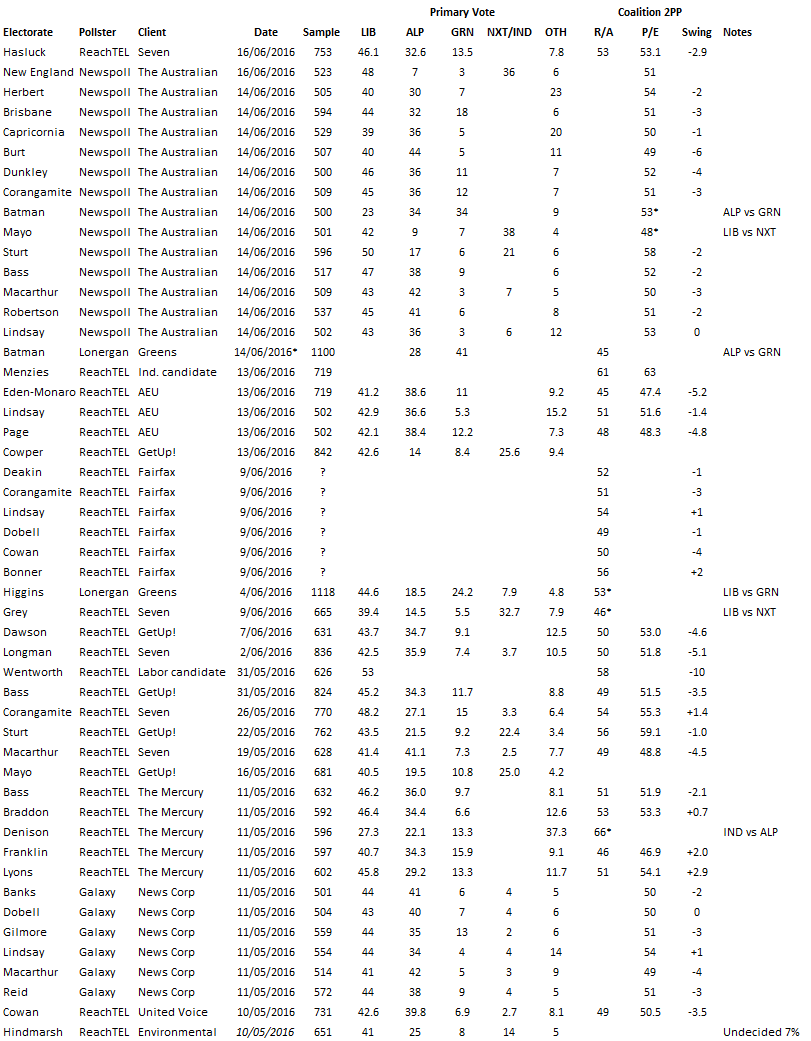The Coalition just keeps its nose in front on the latest ReachTEL national poll. Also featured: marginal seat polling galore.
The latest weekly ReachTEL campaign poll for the Seven Network has two-party preferred unchanged at 51-49 in favour of the Coalition. However, the Coalition is down 1.1% on the primary vote to 42.4% on forced response primary votes, with Labor up 0.2% to the Greens up 1.3% to 10.5%, translating into a 1% shift to Labor if preference flows from the previous election are applied. The failure of this to translate into movement on the headline two-party result is down to a more conventional looking respondent-allocated preference result this week – and perhaps also to the fact that ReachTEL has dropped the Nick Xenophon Team from its list of options outside of South Australia, in recognition of the fact that it won’t be fielding lower house candidates anywhere else (correction – it does have a few candidates here and there). On personal ratings, Malcolm Turnbull records a tick upwards, from 27.4% to 33.5% on the combined very good plus good rating and from 36.3% to 33.3% on poor plus very poor, while Bill Shorten also improves, from 29.6% to 30.7% favourable and 39.7% to 37.8% unfavourable. Turnbull’s lead on preferred prime minister is slightly improved, from 57.6-42.4 to 58.4-41.6.
This week’s regular ReachTEL marginal seat campaign poll for Seven is from Cowper, and it provides more evidence of Rob Oakeshott being highly competitive in his bid to unseat Nationals MP Luke Hartsuyker. The primary votes are Nationals 42.2% (53.9% at the 2013 election post-redistribution), Rob Oakeshott 32.1%, Labor 11.1% (23.6% in 2013) and Greens 8.4% (10.9% in 2013). Based on a 72.7-27.3 respondent-allocated preference flow to Oakeshott, this translated into a two-party preferred result of 50-50.
We’ve also got marginal seat polling galore today courtesy of the News Corp tabloids, with Galaxy polling conducted for its Sydney, Melbourne, Brisbane and Adelaide papers, and ReachTEL going into the field for The Mercury in every seat in Tasmania. The Galaxy polls produce an average swing to Labor of around 2%, and are thus mostly disappointing for them, but the swing in the ReachTEL poll is closer to 3%, which in the Tasmanian context puts three seats on edge. Starting with the Galaxy polls, which surveyed slightly more than 500 respondents per electorate:
• The Daily Telegraph has polls of six Liberal-held marginals in New South Wales, showing every one going down to the wire, with the Liberals fortuitously poking their nose in front in every case but one. Two-party results are 52-48 in Banks (0.5% swing to Labor) and Reid (2.2% swing to Labor), 51-49 in Dobell (1.4% swing to Liberal), Gilmore (3.0% swing to Labor) and Lindsay (2.0% swing to Labor) and 50-50 in Macarthur (3.3% swing to Labor).
• The Herald Sun’s numbers suggest a status quo result across two Liberal-held and two Labor-held seats. The Liberals lead 53-47 in both Corangamite (0.9% swing to Labor) and Dunkley (2.6% swing to Labor), and Labor leads 52-48 in both Bruce (0.2% swing to Labor) and McEwen (1.8% swing to Labor).
• The Courier-Mail reports Labor leads of 54-46 in Petrie (4.5% swing to Labor) and 51-49 in Capricornia (1.8% swing to Labor), Liberal National Party leads of 52-48 in Brisbane (2.3% swing to Labor) and 53-47 in Longman (3.9% swing to Labor), and a 58-42 lead for Bob Katter in Kennedy (5.8% swing to Katter). Also polled was the Labor-held seat of Griffith, where Labor has reportedly been worried, but the poll records a 53-47 result in favour of Labor Terri Butler, unchanged on Kevin Rudd’s winning margin in the seat at the 2013 election.
• The Advertiser reports results of 50-50 in Hindmarsh (1.9% swing to Labor) and 53-47 to the Liberals in Boothby (4.1% swing to Labor). The Nick Xenophon Team was third in both seats, on 19% in Boothby and 16% in Hindmarsh.
ReachTEL’s Tasmanian polls bring better news for Labor, finding them leading in one of the three Liberal-held marginals and dead level in the other two. Denison and Franklin look set to remain with Andrew Wilkie and Labor’s Julie Collins respectively. The polls were conducted last night and have slightly smaller samples than we’ve been used to seeing from ReachTEL, presumably because Tasmania’s electorates themselves have only about three-quarters of those on the mainland. The results:
Bass (Liberal 4.0%): Nothing in it on two-party preferred, from forced preference primary votes of Liberal 42.6% (47.8% last election, 46.2% last poll) Labor 33.4% (34.6% last election, 36.0% last poll) and Greens 10.4% (7.9% last election, 9.7% last poll). The result on previous election preferences would be 51.2-48.8 in favour of Liberal. Sample: 538.
Braddon (Liberal 2.6%): Another tie on two-party preferred, from primary votes of Liberal 42.7% (46.9% last election, 46.4% last poll), Labor 37.9% (37.6% last election, 34.4% last poll) and Greens 8.8% (5.2% last election, 6.6% last poll). Labor has the edge on previous election preferences, at 51.0-49.0. Sample: 566.
Denison (Independent 8.9% versus Liberal): Andrew Wilkie has 34.5% of the primary vote (38.1% at the election, 37.3% last poll), the Liberals are second with 29.5% (23.2% last election, 27.3% last poll), Labor is third on 24.5% (24.8% last election, 22.1% last poll) and the Greens are on 8.7% (7.9% last election, 13.3% last poll). ReachTEL has a 63-35 two-candidate result for Wilkie versus the Labor candidate, but the final count would in fact be between Wilkie and the Liberal, not that it would make much difference to the result. Sample: 552.
Franklin (Labor 5.1%): Labor leads 59-41 from primary votes of Labor 37.1% (39.9% last election, 40.7% last poll), Liberal 37.6% (38.7% last election, 34.3 last poll) and Greens 18.3% (12.2% last election, 15.9% last poll). On previous election preferences, the result is 56.7-43.3. Sample: 550.
Lyons (Liberal 1.2%): Labor has a commanding lead of 55-45 in what has generally been reckoned its likeliest Tasmanian gain, from primary votes of Liberal 40.4% (44.4% last election, 45.8% last poll), Labor 35.2% (36.8% last election, 29.2% last poll) and Greens 11.8% (8.3% last election, 13.3% last poll). The result is a fair bit narrower on previous election preferences, at 51.1-48.9. Sample: 540.
Now here’s the latest BludgerTrack update, inclusive of the ReachTEL national result and (for state breakdown purposes) its Tasmanian polls:







